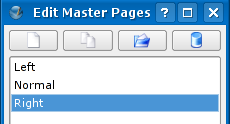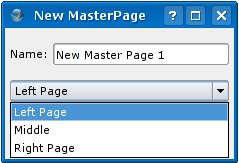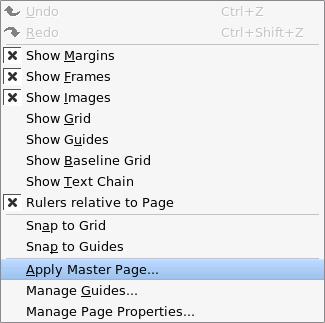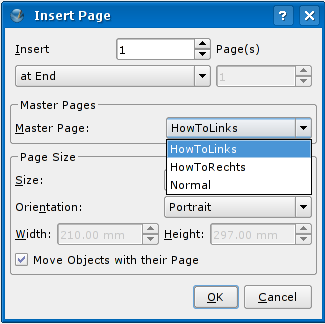Working with Master Pages: Difference between revisions
No edit summary |
|||
| (47 intermediate revisions by 5 users not shown) | |||
| Line 1: | Line 1: | ||
'''Other languages:''' [[Arbeiten mit Musterseiten|Deutsch]] [[Praca ze stronami wzorcowymi|Polski]] | |||
[[Trabalhando com Páginas Mestre|Português]] [[Использование мастер-страниц|Русский]] | |||
{{HOWTO Index}}[[Category:EN]] | |||
''' | |||
{| border="0" cellpadding="2" cellspacing="0" align="right" style="color:white;background:#065682;" | {| border="0" cellpadding="2" cellspacing="0" align="right" style="color:white;background:#065682;" | ||
| Line 28: | Line 22: | ||
| novice | | novice | ||
|} | |} | ||
==Why master pages== | ==Why master pages== | ||
As soon as you consider using many objects (common headers, logos, background, page numbers etc.) on the same places throughout your document, you will be well advised to use master pages. You'll avoid some unnecessary drudgery and spare much time this way. The objects belonging to master pages cannot be changed in the normal Edit Mode. There | {{Working_with_toc}} | ||
As soon as you consider using many objects (common headers, logos, background, page numbers etc.) on the same places throughout your document, you will be well advised to use master pages. You'll avoid some unnecessary drudgery and spare much time this way. The objects belonging to master pages cannot be changed in the normal Edit Mode. There is a good reason for it, since it could easily happen while working with a document that something on a master page would be unintentionally moved or changed. A master page always belongs to a document – it cannot be saved as a separate file. You can however create a sample file containing frequently used master pages and use it as resource to import master pages into other Scribus documents. | |||
==How to create master pages== | ==How to create master pages== | ||
| Line 44: | Line 35: | ||
|- | |- | ||
<!-- Column 1 --> | <!-- Column 1 --> | ||
|valign="top" |Create a new document. Choose ''' | |valign="top" |Create a new document. Choose from the main menu '''Edit > Master Pages...''' (Picture 1) to launch the ''Edit Master Pages'' dialog and to change into the '''Master Pages Edit Mode''' (Picture 2). | ||
|valign="top" | | |||
[[Image:Master pages menu edit.png|thumb|350px|right|Picture 1]] | |||
|} | |||
The master page '''Normal''' is always present and cannot be deleted – the delete button will be disabled, if the master page '''Normal''' is selected (Picture 2). The master page '''Normal''' can be edited, it's better though, to leave it empty to be able to insert new empty pages. | The master page '''Normal''' is always present and cannot be deleted – the delete button will be disabled, if the master page '''Normal''' is selected (Picture 2). The master page '''Normal''' can be edited, it's better though, to leave it empty to be able to insert new empty pages. | ||
| Line 64: | Line 59: | ||
[[Image:Master pages new master page.png|frame|left|Picture 3]] | [[Image:Master pages new master page.png|frame|left|Picture 3]] | ||
{| | |||
After you click '''OK''' you will see the window '''Edit Master Pages''' with your new Master Page highlighted. When you have a list of Master Pages you can then click from one to the next to edit each one as desired (Picture 4). | |After you click '''OK''' you will see the window '''Edit Master Pages''' with your new Master Page highlighted. When you have a list of Master Pages you can then click from one to the next to edit each one as desired (Picture 4). | ||
When you close the '''Edit Master Pages''' window, you return to the normal editing mode in Scribus. | When you close the '''Edit Master Pages''' window, you return to the normal editing mode in Scribus. | ||
If you find that you need a Master Page similar to an existing one, click on '''Duplicate the selected master page''' rather than starting a new Master Page from scratch -- this can be a great time-saver. | If you find that you need a Master Page similar to an existing one, click on '''Duplicate the selected master page''' rather than starting a new Master Page from scratch -- this can be a great time-saver. | ||
|[[Image:Master pages selecting master pages.png|frame|right|Picture 4]] | |||
|} | |||
You can also copy a Master Page from another document by clicking on '''Import master pages from another document''' button, which opens the '''Import Master Page''' window (Picture 5). | You can also copy a Master Page from another document by clicking on '''Import master pages from another document''' button, which opens the '''Import Master Page''' window (Picture 5). | ||
{ | {| | ||
|[[Image:Master pages import.png|frame | |[[Image:Master pages import.png|frame|Picture 5]] | ||
| width=30px | | |||
|Next, click on the button '''Change...''' to search for the document containing the Master Page you would like to import. | | valign=top | Next, click on the button '''Change...''' to search for the document containing the Master Page you would like to import. Then choose your Master Page, and click the '''Import''' button. | ||
|} | |} | ||
<!-- End of table --> | <!-- End of table --> | ||
| Line 102: | Line 92: | ||
<!-- Column 2 --> | <!-- Column 2 --> | ||
|valign="top" | | |valign="top" | | ||
[[Image: | [[Image:Master pages convert2masterpage.png|frame|Picture 6]] | ||
|} | |} | ||
| Line 115: | Line 105: | ||
<!-- Column 1 --> | <!-- Column 1 --> | ||
|valign="top" | | |valign="top" | | ||
[[Image: | [[Image:NewDoc_layout.png|frame|left|Picture 7]] | ||
[[Image: | [[Image:Master_pages_new_double_sided.png|frame|right|Picture 8 - Double Sided]] | ||
[[Image: | [[Image:Master pages new 3fold.png|frame|right|Picture 9 - 3-fold]] | ||
[[Image: | [[Image:Master pages new 4fold.png|frame|right|Picture 10 - 4-fold]] | ||
So how can we use these concepts with Double Sided, 3-fold and 4-fold document layouts? | So how can we use these concepts with Double Sided, 3-fold and 4-fold document layouts? | ||
Actually, you will find that these are situations where using Master Pages is especially useful and time-saving. When you create a new document, select your desired layout(Picture 7). | Actually, you will find that these are situations where using Master Pages is especially useful and time-saving. When you create a new document, select your desired layout (Picture 7). | ||
After this, create your Master Pages as explained above for Plan A or Plan B. To the right we see why the name chosen for a Master Page is especially important and helpful. | After this, create your Master Pages as explained above for Plan A or Plan B. To the right we see why the name chosen for a Master Page is especially important and helpful. | ||
| Line 135: | Line 125: | ||
==Applying master pages== | ==Applying master pages== | ||
===To empty document pages:=== | ===To empty document pages:=== | ||
| Line 149: | Line 137: | ||
<!-- Column 2 --> | <!-- Column 2 --> | ||
|valign="top" | | |valign="top" | | ||
[[Image: | [[Image:Master pages apply.png|frame|right|Picture 12]] | ||
|} | |} | ||
<!-- End of table --> | <!-- End of table --> | ||
Selecting either '''Page > Apply Master Page...''' (Picture | Selecting either '''Page > Apply Master Page...''' (Picture 6) or '''Apply Master Page...''' from the context menu (right-click on the page - Picture 11) opens up the '''Apply Master Page''' window. From this you may choose to apply the Master page to the: | ||
* Current page | * Current page | ||
| Line 172: | Line 160: | ||
<!-- Column 1 --> | <!-- Column 1 --> | ||
|valign="top" | | |valign="top" | | ||
[[Image: | [[Image:Master pages insert new page.png|frame|left|Picture 13]] | ||
When you insert a new page (menu bar '''Page > Insert'''), you open up a window from which you can choose to add one or more pages, choose the place of insertion, and in addition decide whether these new pages will contain Master Page elements (Picture 13). | |||
Note that the '''Master Pages''' area expands according to your layout, so that in Picture 14 we see the appearance of an '''Insert Page''' window for a 4-fold layout. | |||
'''Hint:''' | '''Hint:''' | ||
Page numbering is best accomplished with Story Editor. While you are in Edit Master Page mode, create a text frame with the appropriate location for your page numbering. From the Story Editor menu, select '''Insert > Character > Page Number''' (keyboard: '''Ctrl+Shift+Alt+P'''). This appears as <font color="red">#</font> in the Story Editor window, but this is not Shift+3. | |||
For two digit page numbers (10-99), use two of these special characters, and use three special characters for pages 100-999. If you use the same master page for all pages in a long document, you can put two or three page number characters on the master page, and Scribus will ignore the redundant digits on low-numbered pages. | |||
<!-- Column 2 --> | <!-- Column 2 --> | ||
|valign="top" | | |valign="top" | | ||
[[Image: | [[Image:Master pages 4fold newpage.png|frame|Picture 14]] | ||
|} | |} | ||
<!-- End of table --> | <!-- End of table --> | ||
<div style="text-align:center;background-color:# | <div style="text-align:center;background-color:#5599bb;color:white"> | ||
</div> | [[Arbeiten mit Musterseiten| '''The first German version''']] of this howto was originally published in the German Scribus Forum. </div> | ||
Latest revision as of 06:42, 14 January 2011
Other languages: Deutsch Polski Português Русский
| Installation • Usage • PDF issues • Imposition • Other |
| Requirements: | |
| Operating system: | any |
| Scribus Version: | stable 1.3.3.* series |
| DTP skills: | novice |
Why master pages
| All Working with pages:
Working with text frames |
As soon as you consider using many objects (common headers, logos, background, page numbers etc.) on the same places throughout your document, you will be well advised to use master pages. You'll avoid some unnecessary drudgery and spare much time this way. The objects belonging to master pages cannot be changed in the normal Edit Mode. There is a good reason for it, since it could easily happen while working with a document that something on a master page would be unintentionally moved or changed. A master page always belongs to a document – it cannot be saved as a separate file. You can however create a sample file containing frequently used master pages and use it as resource to import master pages into other Scribus documents.
How to create master pages
Plan A:
| Create a new document. Choose from the main menu Edit > Master Pages... (Picture 1) to launch the Edit Master Pages dialog and to change into the Master Pages Edit Mode (Picture 2). |
The master page Normal is always present and cannot be deleted – the delete button will be disabled, if the master page Normal is selected (Picture 2). The master page Normal can be edited, it's better though, to leave it empty to be able to insert new empty pages.
If you move your mouse over the buttons, you will see some helpful tooltips (Picture 2).
Beginning from the left side:
- New Master Page
- Duplicate Master Page
- Import Master Page
- Delete Master Page
Clicking on the Button Add a New Master Page opens a window in which you may give your page a name (Picture 3).
Tip: try to pick a name that will have some meaning describing its purpose, so that if you haven't used it for a while, its name gives a clue.
| After you click OK you will see the window Edit Master Pages with your new Master Page highlighted. When you have a list of Master Pages you can then click from one to the next to edit each one as desired (Picture 4).
When you close the Edit Master Pages window, you return to the normal editing mode in Scribus. If you find that you need a Master Page similar to an existing one, click on Duplicate the selected master page rather than starting a new Master Page from scratch -- this can be a great time-saver. |
You can also copy a Master Page from another document by clicking on Import master pages from another document button, which opens the Import Master Page window (Picture 5).
| Next, click on the button Change... to search for the document containing the Master Page you would like to import. Then choose your Master Page, and click the Import button. |
Plan B:
|
You can also create new Master Pages from the page you are editing in normal editing mode. From the menu bar select Page > Convert to Master Page... (Picture 6). This opens a window entitled Convert Page to Master in which you may give this new Master Page a name (similar to Picture 3 above). Afterward, you may then go back to Edit > Master Pages... where you will find your new Master Page in the Edit Master Pages window (Picture 4 above). |
Double sided, 3-fold and 4-fold Pages
|
So how can we use these concepts with Double Sided, 3-fold and 4-fold document layouts? Actually, you will find that these are situations where using Master Pages is especially useful and time-saving. When you create a new document, select your desired layout (Picture 7). After this, create your Master Pages as explained above for Plan A or Plan B. To the right we see why the name chosen for a Master Page is especially important and helpful.
|
Applying master pages
To empty document pages:
Selecting either Page > Apply Master Page... (Picture 6) or Apply Master Page... from the context menu (right-click on the page - Picture 11) opens up the Apply Master Page window. From this you may choose to apply the Master page to the:
- Current page
- Even pages
- Odd pages
- All pages
- and you may apply to a range of pages
Select the desired Master Page from the drop-down list labeled Master Page.
Perhaps not surprisingly, the option Even pages can only be selected when the document has more than one page. Also, applying to a range of pages only applies when you have selected All pages.
Inserting as a new page:
|
When you insert a new page (menu bar Page > Insert), you open up a window from which you can choose to add one or more pages, choose the place of insertion, and in addition decide whether these new pages will contain Master Page elements (Picture 13). Note that the Master Pages area expands according to your layout, so that in Picture 14 we see the appearance of an Insert Page window for a 4-fold layout. Hint: Page numbering is best accomplished with Story Editor. While you are in Edit Master Page mode, create a text frame with the appropriate location for your page numbering. From the Story Editor menu, select Insert > Character > Page Number (keyboard: Ctrl+Shift+Alt+P). This appears as # in the Story Editor window, but this is not Shift+3. For two digit page numbers (10-99), use two of these special characters, and use three special characters for pages 100-999. If you use the same master page for all pages in a long document, you can put two or three page number characters on the master page, and Scribus will ignore the redundant digits on low-numbered pages.
|













